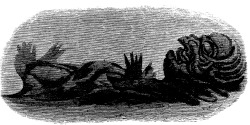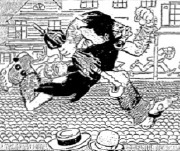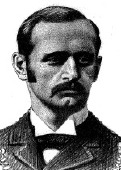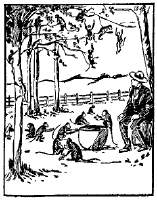
"Effigy in Lava"
(
Harper's Magazine, 1863)
In October 1875 two hunters reported finding a small stone man, or "petrified baby" as some newspapers dubbed it, embedded in a gravel bank alongside Pine River in Michigan. The petrified baby was about four feet tall, with an extremely wide, flat forehead. Local papers offered the following description of it:
The right arm is bent. The forearm is lying across the body; the other is bent below the elbow. The eyes are well defined and very broad; forehead flat and sloping. Nose, small, sharp; nostrils open; lips very thin, flat; mouth well defined — curve of the lips perfectly natural; chin square; slight depression or dimple over the breast bone, also just above the arm where the ribs meet, or at least just below where they meet. The form of the breast is perfect. The skin on the surface is smooth, not showing the marks of tools. Some call it a petrified child, and account for the great bredth of the head at the eyes by some pressure that flattened the forehead.
The find attracted some attention as a curiosity, but most speculated that it was a "second edition of the Cardiff Giant," the notorious stone-giant hoax of 1869.
The skeptics were correct. The petrified baby had been manufactured by William Ruddock of Thornton, Michigan. Reportedly, he used as his model a picture of an Icelandic "effigy in lava" that appeared in an 1863 edition of Harper's Magazine.
Ruddock had hoped to make a profit by displaying the petrified baby to the public, but he didn't earn enough to cover his costs. Eventually he sold it to a side show.
More…


 Under the heading "Posthumous Poetry," Indiana's Kokomo Dispatch published a poem titled "Leonainie" on August 3, 1877. It was an unremarkable poem except in one way. The editor of the Dispatch, John Henderson, claimed it was a previously unpublished poem by Edgar Allan Poe. (Click here to read the poem.)
Under the heading "Posthumous Poetry," Indiana's Kokomo Dispatch published a poem titled "Leonainie" on August 3, 1877. It was an unremarkable poem except in one way. The editor of the Dispatch, John Henderson, claimed it was a previously unpublished poem by Edgar Allan Poe. (Click here to read the poem.) In August 1895 New York City papers received a wire story about a naked, hairy man that was terrorizing townspeople in Winsted, Connecticut. Intrigued, the papers sent reporters up to Winsted to find out what was happening.
In August 1895 New York City papers received a wire story about a naked, hairy man that was terrorizing townspeople in Winsted, Connecticut. Intrigued, the papers sent reporters up to Winsted to find out what was happening. Louis Timothy Stone (1875-1933), more popularly known as Lou Stone, or the Winsted Liar, was a journalist famous for the hundreds of fanciful articles he wrote about the strange flora and fauna surrounding his hometown of Winsted, Connecticut. It was said he had a "faculty for seeing the unusual in stories."
More…
Louis Timothy Stone (1875-1933), more popularly known as Lou Stone, or the Winsted Liar, was a journalist famous for the hundreds of fanciful articles he wrote about the strange flora and fauna surrounding his hometown of Winsted, Connecticut. It was said he had a "faculty for seeing the unusual in stories."
More…
 William Randolph Hearst, owner of the New York Journal, had a reputation for never letting truth get in the way of a good story. According to one famous tale, when hostilities broke out between the Spanish and the Cubans, Hearst sent the illustrator Frederic Remington to Cuba to draw pictures of the conflict. Finding that not much was happening, Remington cabled Hearst in January 1897: "Everything is quiet. There is no trouble here. There will be no war. I wish to return."
William Randolph Hearst, owner of the New York Journal, had a reputation for never letting truth get in the way of a good story. According to one famous tale, when hostilities broke out between the Spanish and the Cubans, Hearst sent the illustrator Frederic Remington to Cuba to draw pictures of the conflict. Finding that not much was happening, Remington cabled Hearst in January 1897: "Everything is quiet. There is no trouble here. There will be no war. I wish to return." Prescott Jernegan claimed he had found a way to cheaply extract gold from sea water. His "Gold Accumulator" consisted of a wooden box, inside of which was a pan of mercury mixed with a secret ingredient. A wire connected the mercury to a small battery. When lowered into the ocean, this contraption supposedly sucked gold out of the water.
Prescott Jernegan claimed he had found a way to cheaply extract gold from sea water. His "Gold Accumulator" consisted of a wooden box, inside of which was a pan of mercury mixed with a secret ingredient. A wire connected the mercury to a small battery. When lowered into the ocean, this contraption supposedly sucked gold out of the water. In February 1899, numerous American newspapers, including the Los Angeles Times, printed a story claiming that a farmer, W.W. Mangum, had successfully trained monkeys to pick cotton on his plantation in Smedes, Mississippi. The story was sourced to an article in the Cotton Planters' Journal by T.G. Lane. Reportedly Mangum was so pleased with the success of his monkey-labor experiment that he had ordered more monkeys from Africa, and he was urging other planters to join him in using simians as laborers. There is no evidence this story was true. In fact, the tale of monkeys being trained to pick cotton (or other crops) was one of the more persistent legends that circulated in the American South during the second half of the nineteenth century. Versions of it appeared in newspapers every few years.
More…
In February 1899, numerous American newspapers, including the Los Angeles Times, printed a story claiming that a farmer, W.W. Mangum, had successfully trained monkeys to pick cotton on his plantation in Smedes, Mississippi. The story was sourced to an article in the Cotton Planters' Journal by T.G. Lane. Reportedly Mangum was so pleased with the success of his monkey-labor experiment that he had ordered more monkeys from Africa, and he was urging other planters to join him in using simians as laborers. There is no evidence this story was true. In fact, the tale of monkeys being trained to pick cotton (or other crops) was one of the more persistent legends that circulated in the American South during the second half of the nineteenth century. Versions of it appeared in newspapers every few years.
More…
 Woolly mammoths became extinct thousands of years ago. But in October, 1899 a story appeared in McClure's Magazine titled "The Killing of the Mammoth" in which a narrator named H. Tukeman described how he had recently hunted down and killed a mammoth in the Alaskan wilderness.
More…
Woolly mammoths became extinct thousands of years ago. But in October, 1899 a story appeared in McClure's Magazine titled "The Killing of the Mammoth" in which a narrator named H. Tukeman described how he had recently hunted down and killed a mammoth in the Alaskan wilderness.
More…
19th-Century Hoaxes (1850-1900)